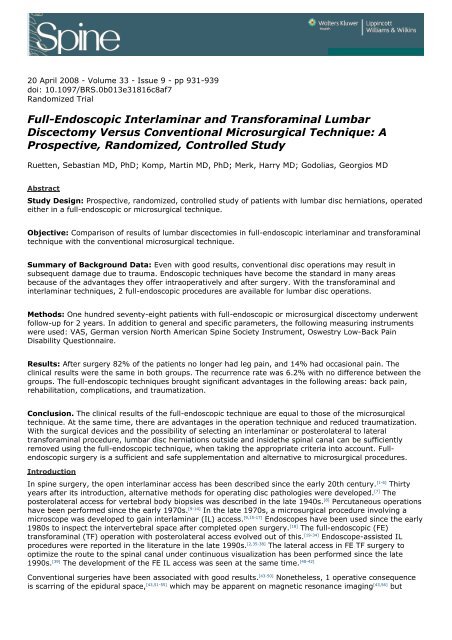Full-Endoscopic Interlaminar and Transforaminal ... - Max-more
Full-Endoscopic Interlaminar and Transforaminal ... - Max-more
Full-Endoscopic Interlaminar and Transforaminal ... - Max-more
Create successful ePaper yourself
Turn your PDF publications into a flip-book with our unique Google optimized e-Paper software.
20 April 2008 - Volume 33 - Issue 9 - pp 931-939<br />
doi: 10.1097/BRS.0b013e31816c8af7<br />
R<strong>and</strong>omized Trial<br />
<strong>Full</strong>-<strong>Endoscopic</strong> <strong>Interlaminar</strong> <strong>and</strong> <strong>Transforaminal</strong> Lumbar<br />
Discectomy Versus Conventional Microsurgical Technique: A<br />
Prospective, R<strong>and</strong>omized, Controlled Study<br />
Ruetten, Sebastian MD, PhD; Komp, Martin MD, PhD; Merk, Harry MD; Godolias, Georgios MD<br />
Abstract<br />
Study Design: Prospective, r<strong>and</strong>omized, controlled study of patients with lumbar disc herniations, operated<br />
either in a full-endoscopic or microsurgical technique.<br />
Objective: Comparison of results of lumbar discectomies in full-endoscopic interlaminar <strong>and</strong> transforaminal<br />
technique with the conventional microsurgical technique.<br />
Summary of Background Data: Even with good results, conventional disc operations may result in<br />
subsequent damage due to trauma. <strong>Endoscopic</strong> techniques have become the st<strong>and</strong>ard in many areas<br />
because of the advantages they offer intraoperatively <strong>and</strong> after surgery. With the transforaminal <strong>and</strong><br />
interlaminar techniques, 2 full-endoscopic procedures are available for lumbar disc operations.<br />
Methods: One hundred seventy-eight patients with full-endoscopic or microsurgical discectomy underwent<br />
follow-up for 2 years. In addition to general <strong>and</strong> specific parameters, the following measuring instruments<br />
were used: VAS, German version North American Spine Society Instrument, Oswestry Low-Back Pain<br />
Disability Questionnaire.<br />
Results: After surgery 82% of the patients no longer had leg pain, <strong>and</strong> 14% had occasional pain. The<br />
clinical results were the same in both groups. The recurrence rate was 6.2% with no difference between the<br />
groups. The full-endoscopic techniques brought significant advantages in the following areas: back pain,<br />
rehabilitation, complications, <strong>and</strong> traumatization.<br />
Conclusion. The clinical results of the full-endoscopic technique are equal to those of the microsurgical<br />
technique. At the same time, there are advantages in the operation technique <strong>and</strong> reduced traumatization.<br />
With the surgical devices <strong>and</strong> the possibility of selecting an interlaminar or posterolateral to lateral<br />
transforaminal procedure, lumbar disc herniations outside <strong>and</strong> insidethe spinal canal can be sufficiently<br />
removed using the full-endoscopic technique, when taking the appropriate criteria into account. <strong>Full</strong>endoscopic<br />
surgery is a sufficient <strong>and</strong> safe supplementation <strong>and</strong> alternative to microsurgical procedures.<br />
Introduction<br />
In spine surgery, the open interlaminar access has been described since the early 20th century. [1-6] Thirty<br />
years after its introduction, alternative methods for operating disc pathologies were developed. [7] The<br />
posterolateral access for vertebral body biopsies was described in the late 1940s. [8] Percutaneous operations<br />
have been performed since the early 1970s. [9-14] In the late 1970s, a microsurgical procedure involving a<br />
microscope was developed to gain interlaminar (IL) access. [9,15-17] Endoscopes have been used since the early<br />
1980s to inspect the intervertebral space after completed open surgery. [18] The full-endoscopic (FE)<br />
transforaminal (TF) operation with posterolateral access evolved out of this. [19-34] Endoscope-assisted IL<br />
procedures were reported in the literature in the late 1990s. [2,35-38] The lateral access in FE TF surgery to<br />
optimize the route to the spinal canal under continuous visualization has been performed since the late<br />
1990s. [39] The development of the FE IL access was seen at the same time. [40-42]<br />
Conventional surgeries have been associated with good results. [43-50] Nonetheless, 1 operative consequence<br />
is scarring of the epidural space, [43,51-55] which may be apparent on magnetic resonance imaging [43,56] but
ecomes clinically symptomatic in 10% or <strong>more</strong> of cases [51,52,55] <strong>and</strong> makes revision surgery <strong>more</strong> difficult. An<br />
analysis of study results revealed the occurrence of operation-induced destabilization due to the necessary<br />
resection of spinal canal structures. [1,47,57-62] The point of access influences the stabilization <strong>and</strong> coordination<br />
system in the innervation area of the dorsal nerve roots of the spinal nerves. [53,63,64] The combination of these<br />
parameters may explain poor revision-related results. [52,65,66] The use of microsurgical techniques has reduced<br />
tissue damage <strong>and</strong> its consequences. [38,67,68] Although conditions of postoperative pain are treatable, [54,69,70]<br />
continuous technical optimization should be attempted. The goal of a new procedure must be to achieve<br />
results that commensurate with current results [71] while minimizing traumatization <strong>and</strong> its negative longterm<br />
consequences.<br />
Minimally-invasive techniques can reduce tissue damage <strong>and</strong> its consequences. [38,67,68] <strong>Endoscopic</strong> operations<br />
have become the st<strong>and</strong>ard in many areas. The most widely used FE procedure in patients with lumbar disc<br />
disease is TF surgery. [19-23,26-34,72] Laser <strong>and</strong> bipolar current may be applied. [73-75] Removal of the intra- or<br />
extraforaminal sequestered material is technically possible. [26,76] Resection of the sequestered nucleus<br />
pulposus material within the spinal canal-that is, a retrograde resection performed intradiscally through the<br />
existing anular defect-has been described. [19-21,31,32,34,77-79] Nonetheless, difficulty in achieving an adequate<br />
resection of herniated discs within the spinal canal cannot always be excluded. [20,39,80-82] With the lateral<br />
approach, the spinal canal can be reached <strong>more</strong> sufficiently under continuous visualization, [39] But the<br />
osseous perimeter of the foramen <strong>and</strong> the exiting nerve can limit the working mobility <strong>and</strong> excision of<br />
dislocated herniated material. [20,31,39] Moreover, the pelvis <strong>and</strong> the abdominal structures may block access.<br />
Thus, there can be limitations to the TF procedure. [39,40-42] The FE IL access has been developed to enable the<br />
extirpation of pathologic entities not successfully achieved using the TF technique. [40-42]<br />
The goal of this prospective, r<strong>and</strong>omized, controlled study was to compare the results of lumbar<br />
discectomies in FE technique via IL <strong>and</strong> TF approach with those of the conventional microsurgical technique.




